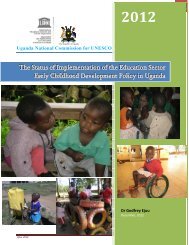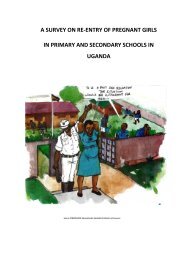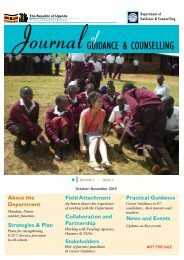Download Pdf - Ministry of Education and Sports
Download Pdf - Ministry of Education and Sports
Download Pdf - Ministry of Education and Sports
You also want an ePaper? Increase the reach of your titles
YUMPU automatically turns print PDFs into web optimized ePapers that Google loves.
104<br />
120.00%<br />
100.00%<br />
Survival Rate to P.5<br />
80.00%<br />
60.00%<br />
40.00%<br />
20.00%<br />
0.00%<br />
2001 2002 2003 2004 2005 2006 2007 2008 2009 2010 2011 2012 2015*<br />
Total 58.50% 55.25% 52% 55.7% 52% 49.5% 49% 54.1% 60.9% 60% 58% 59% 100%<br />
Male 58.90% 55.45% 52% 55.2% 52% 49.2% 49% 53.3% 60% 60% 57% 58% 100%<br />
Female 58% 54.50% 51% 56.2% 53% 49.8% 50% 54.9% 61.8% 61% 59% 60% 100%<br />
Sourc<br />
e: EMIS 20012012<br />
Over the reviewed period, there was relative gradual improvement across gender in the number <strong>of</strong><br />
girls within each successive cohort <strong>of</strong> pupils that enroll in P.1 <strong>and</strong> successively reach P.5 in the last<br />
three years. Out <strong>of</strong> 1,712,420 (male 859,343; female 853,077) pupils who started P.1 in 2005, 60 % (male<br />
61.8%; female 60.9%) successively reached grade five in 2009 as compared to 53.3% in 2008. In 2012,<br />
the survival rate was 59% (male 58%; female 60%). Results show that more females successfully survive<br />
to grade five as compared to males. However, the target <strong>of</strong> 100 percent survival rate to grate five is<br />
not likely to be met by 2015 given the current gap <strong>of</strong> 41 percent (male 42%; female 40%).<br />
7.3.2.3 Primary Seven Completion Rates<br />
Year<br />
The completion rate influences a country’s level <strong>of</strong> literacy <strong>and</strong> numeracy as well as the level <strong>of</strong><br />
development <strong>of</strong> the education system. Completion rates for primary education remain below the<br />
desired target <strong>of</strong> 100 percent. Figure 4.36 below shows Ug<strong>and</strong>a’s Primary Completion rate for the last<br />
eleven years;<br />
Figure 4.36: Primary Seven Completion Rates<br />
120%<br />
100%<br />
P.7 Completion Rate<br />
80%<br />
60%<br />
40%<br />
20%<br />
0%<br />
2002 2003 2004 2005 2006 2007 2008 2009 2010 2011 2012 2015*<br />
Total 49% 56% 54% 51% 48% 47% 49% 52% 54% 64% 67% 100%<br />
Male 59% 66% 60% 54% 55% 50% 51% 55% 56% 65% 68% 100%<br />
Female 41% 47% 47% 47% 42% 44% 47% 48% 51% 63% 66% 100%<br />
Year<br />
: EMIS, 20022012<br />
Source<br />
Ug<strong>and</strong>a’s primary completion rates stagnated between 2006 <strong>and</strong> 2008. In 2009, only 52% <strong>of</strong> the<br />
children completed primary seven. Since then, the completion rate has been improving steadily. In<br />
2012, the completion rate improved by 3%age points from 64% in 2011 to 67% (68% male; 66% female)<br />
in 2012. Based on studies conducted in Ug<strong>and</strong>a <strong>and</strong> else were in the world, enhancement <strong>of</strong> financial<br />
support to ECD would result into improved completion rate <strong>and</strong> perhaps meeting the desired 100<br />
ESSAPR FY 2011/12 to inform the 19 th ESSR – OCTOBER 2012








